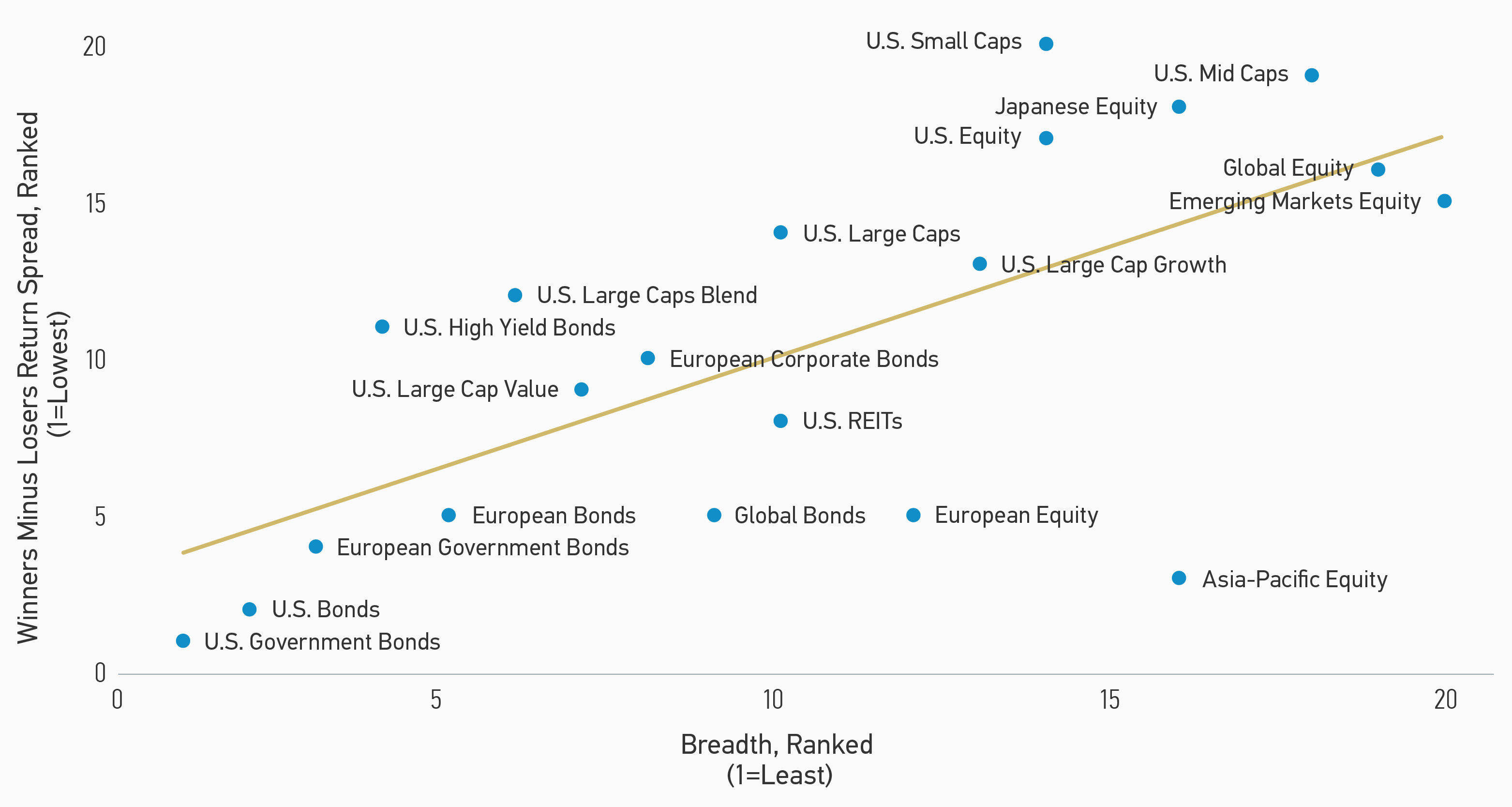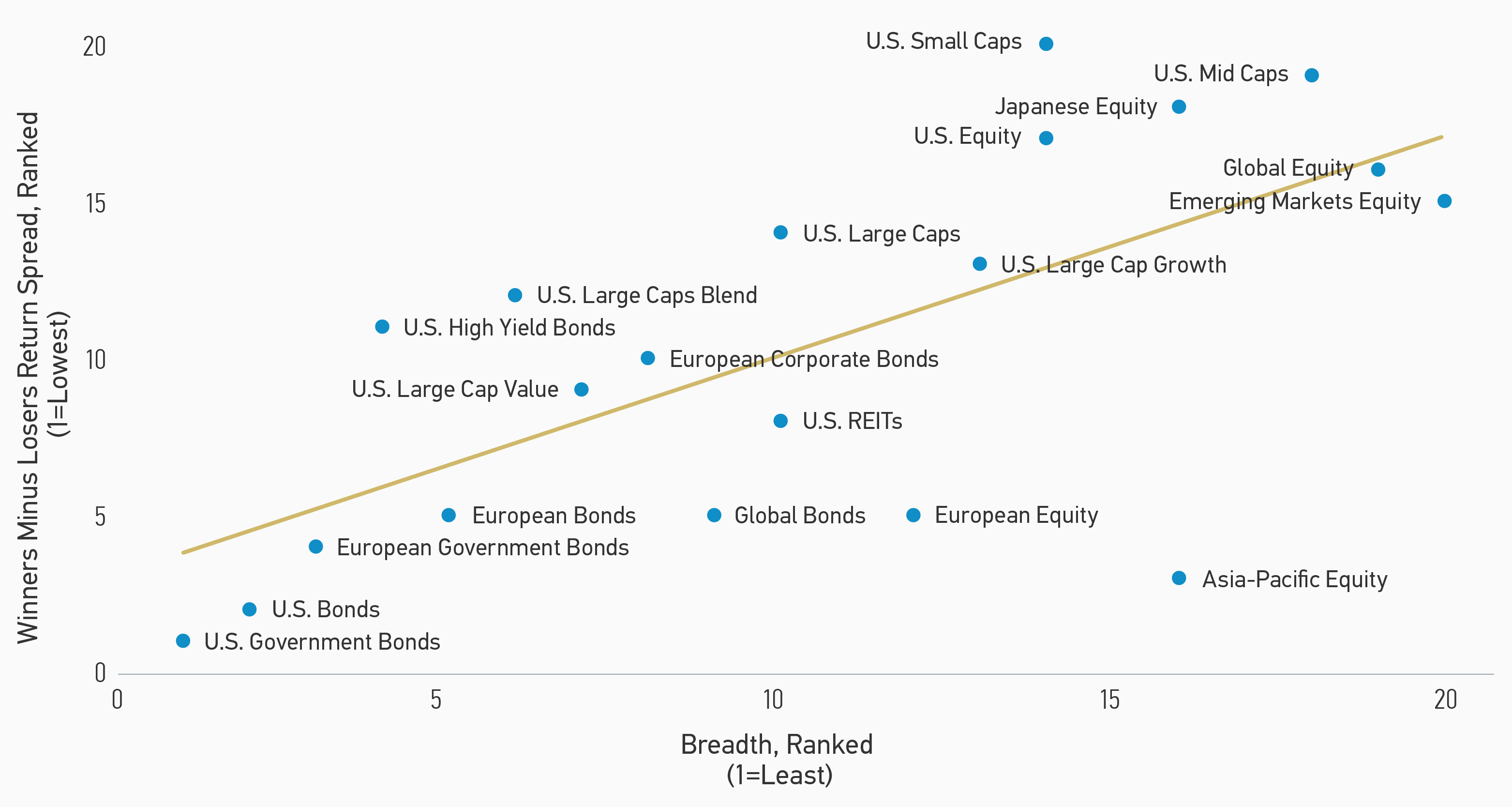How Dispersion Creates the Opportunity to Express Skill
Napoleon Bonaparte purportedly said, “Ability is nothing without opportunity.” Having skill at an activity tends to be a good thing, but for skill to have a payoff there has to be opportunity. The winning formula is the combination of skill and the opportunity to express it.
An investor’s excess return equals skill times opportunity. More formally,1 it is
Information Ratio = Information Coefficient ∗ √𝐵𝑟𝑒𝑎𝑑𝑡ℎ
Information ratio (IR) measures the return of a portfolio adjusted for risk by dividing the portfolio’s excess return versus a benchmark by the tracking error. Information coefficient (IC) is the average correlation between forecasts and outcomes. And breadth (BR) is the number of independent opportunities for investments that offer excess returns over a period. Breadth tends to be related to the dispersion of asset returns.
Two essential themes for investors come out of a discussion of skill and opportunity sets. First, it is crucial to think about your source of edge and to align your organization’s process to serve that end. Second, a big part of winning is finding a game that allows you to show your skill.
Investors can express skill in three ways: market timing, security selection and position sizing. It’s not how often you are right that matters; it’s how much money you make when you’re right versus how much money you lose when you’re wrong.
But all the skill in the world is useless if there is no opportunity. There are a few ways this can happen. First, a skillful participant does not get to play the game, a result of capital or other constraints. Second, the cost to play may be too high due to arbitrage costs. Finally, skill is obscured if the opportunity does not offer differentiated payoffs.
To quantify opportunity, we look at dispersion. Dispersion measures the range of returns for a group of stocks. Generating a return in excess of the benchmark is really hard if the gains or losses in the underlying stocks are all very similar to those of the benchmark. On the other hand, there is a bountiful opportunity to pick the winners, avoid the losers and create a portfolio that meaningfully beats the benchmark if the dispersion of the constituent stocks is high. Research shows that dispersion is a reasonable proxy for breadth and that the results for skillful mutual fund managers are better when dispersion is high.
Display 1 shows the relationship between breadth and the gap between winners and losers. The data reveal that it is very difficult for a manager to distinguish him or herself in an asset class with low breadth and that the gap between winners and losers is much more pronounced in asset classes with high breadth.
Display 1: Higher Dispersion Allows for Enhanced Expression of Skill Across Asset Classes

Source: Joop Huij and Simon Lansdorp, “Mutual Fund Performance Persistence, Market Efficiency, and Breadth,” Working Paper, October 25, 2012.
Note: The chart is provided for illustrative purposes only and is not meant to depict the performance of a specific investment. Past performance is no guarantee of future results.
Display 1: Higher Dispersion Allows for Enhanced Expression of Skill Across Asset Classes

Source: Joop Huij and Simon Lansdorp, “Mutual Fund Performance Persistence, Market Efficiency, and Breadth,” Working Paper, October 25, 2012.
Note: The chart is provided for illustrative purposes only and is not meant to depict the performance of a specific investment. Past performance is no guarantee of future results.
Looking at the relationship between annual dispersion and standard deviation of alpha, a measure of the width of the distribution of alpha, shows the same clear relationship. More dispersion tends to spell more opportunity. Talented managers need dispersion in order to ply their skill.
No matter how you seek to generate excess returns—whether through batting averages or slugging ratios—it is vital that you have a roadmap to those returns and that your process is congruent with that objective. But there must also be a chance to express skill. Even the most talented will not fare well if they have no occasion to do so. Dispersion is one way to measure this opportunity set, and there is solid research behind the idea that high dispersion presents the opportunity for skilled managers to generate excess returns.
1 Richard C. Grinold, “The Fundamental Law of Active Management,” Journal of Portfolio Management, Vol. 15, No. 3, Spring 1989, 30-37.
Counterpoint Global
Counterpoint Global’s culture fosters collaboration, creativity, continued development and differentiated thinking.
Featured Insights
The views and opinions are those of the author as of the date of publication and are subject to change at any time due to market or economic conditions and may not necessarily come to pass. The views expressed do not reflect the opinions of all investment personnel at Morgan Stanley Investment Management (MSIM) and its subsidiaries and affiliates (collectively the Firm"), and may not be reflected in all the strategies and products that the Firm offers.
This material is for the benefit of persons whom the Firm reasonably believes it is permitted to communicate to and should not be forwarded to any other person without the consent of the Firm. It is not addressed to any other person and may not be used by them for any purpose whatsoever. It expresses no views as to the suitability of the investments described herein to the individual circumstances of any recipient or otherwise. It is the responsibility of every person reading this material to fully observe the laws of any relevant country, including obtaining any governmental or other consent which may be required or observing any other formality which needs to be observed in that country.
This material is a general communication, which is not impartial, is for informational and educational purposes only, not a recommendation to purchase or sell specific securities, or to adopt any particular investment strategy. Information does not address financial objectives, situation or specific needs of individual investors.
Any charts and graphs provided are for illustrative purposes only. Any performance quoted represents past performance. Past performance does not guarantee future results. All investments involve risks, including the possible loss of principal.
Prior to making any investment decision, investors should carefully review the strategy's relevant offering document. For the complete content and important disclosures, refer to the Article's PDF.









